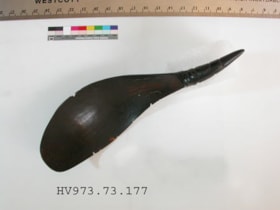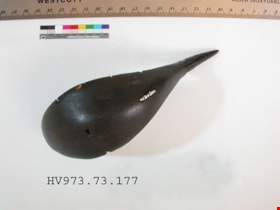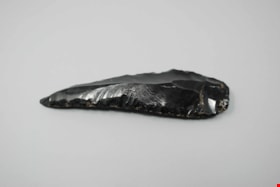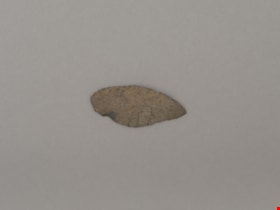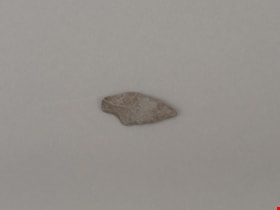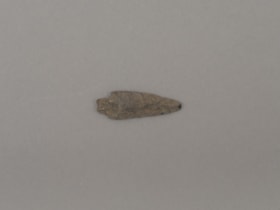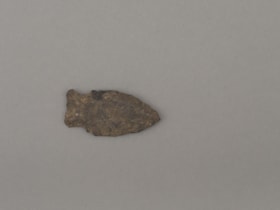More like 'Interview with Maureen Olofson by Kathy Bossort October 14, 2015 - Track 2'
Narrow Results By
Subject
- Agriculture 1
- Agriculture - Farms 2
- Archeological Specimen 33
- Armament 18
- Arts 1
- Buildings - Commercial - Grocery Stores 1
- Buildings - Commercial - Restaurants 3
- Buildings - Commercial - Service Stations 1
- Buildings - Industrial - Saw Mills 1
- Buildings - Religious - Monasteries 1
- Buildings - Religious - Mosques 1
- Businesses 1
Creator
- Anders, F. 1
- Anders, Fred 1
- Bennett, D. 1
- Binks, James 5
- Buccino, Fred 1
- Burnaby Village Museum 18
- Bussey, Anthea J. 1
- Cabeldu Motors Limited 1
- Canada. Department of Labour Economics and Research Branch 2
- Canada. Department of Mines and Technical Surveys. Geographical Branch 1
- Canadian National Railways 1
- Canadian Pacific Railway Company 1
Person / Organization
- Alpha Secondary School 1
- Arora, Maninder 1
- Babey, Beverley 1
- Binning, Dr. Sadhu 1
- Binning, Gurmaje Kaur 1
- Binning, Jagdish 1
- Binning, Jit Singh 1
- Brentwood Park School 1
- Brentwood Shopping Centre 1
- British Columbia Electric Railway Company 1
- British Columbia Hydro and Power Authority 1
- British Columbia Organization to Fight Racism 1
hand maul
https://search.heritageburnaby.ca/link/museumartifact3392
- Repository
- Burnaby Village Museum
- Accession Code
- BV988.6.1
- Description
- Flat topped stone maul.
- Subjects
- Persons
- Indigenous peoples - British Columbia
- Woodworking Tools and Equipment
- Woodworking Tools and Equipment - Maul
Images
Documents
hand maul
https://search.heritageburnaby.ca/link/museumartifact3393
- Repository
- Burnaby Village Museum
- Accession Code
- BV988.6.2
- Description
- Flat topped stone maul, broken
- Subjects
- Persons
- Indigenous peoples - British Columbia
- Woodworking Tools and Equipment
- Woodworking Tools and Equipment - Maul
Images
Documents
hand maul
https://search.heritageburnaby.ca/link/museumartifact15555
- Repository
- Burnaby Village Museum
- Accession Code
- HV983.32.13
- Description
- Nipple topped stone maul. Nipple topped stone maul. It has a crack through the entire shaft and the two halves look of different colour and stone type. There is a large chip missing along the crack.
- Object History
- The donor was of European decent and was given this maul by an unidentified person. In general, hand mauls are used in woodworking todrive antler wedges or spreading sticks into logs and split planks. They were also used in combination with chisels for detail work. Their presence at an archeological site is viewed as evidence of long term habitations. They are associated with house building, canoe building, housepost and welcome figure carving. Nipple top hand mauls are identified as Marpole Culture (400 BC - 400 AD).
- Country Made
- Canada
- Province Made
- British Columbia
- Culture
- First Nations
- Subjects
- Persons
- Indigenous peoples - British Columbia
- Woodworking Tools and Equipment
- Woodworking Tools and Equipment - Maul
Images
Documents
hand maul
https://search.heritageburnaby.ca/link/museumartifact34041
- Repository
- Burnaby Village Museum
- Accession Code
- BV991.26.1
- Description
- Conical topped stone maul; damaged area on one side; broken area at bottom edge.
- Object History
- Maul was found in the late 1920s by Joseph Theodore Dorman on his property on Cliff Avenue, between Halifax and Broadway. In general, hand mauls are used in woodworking todrive antler wedges or spreading sticks into logs and split planks. They were also used in combination with chisels for detail work. Their presence at an archeological site is viewed as evidence of long term habitations. They are associated with house building, canoe building, housepost and welcome figure carving. Nipple top hand mauls are identified as Marpole Culture (400 BC - 400 AD).
- Country Made
- Canada
- Province Made
- British Columbia
- Subjects
- Persons
- Indigenous peoples - British Columbia
- Woodworking Tools and Equipment
- Woodworking Tools and Equipment - Maul
Images
Documents
hand maul
https://search.heritageburnaby.ca/link/museumartifact34042
- Repository
- Burnaby Village Museum
- Accession Code
- BV991.26.2
- Description
- Nipple topped stone maul. There is a damaged area on one side and the bottom edge is badly chipped. There are blackish oily stains on the side of the maul.
- Object History
- Was found in the late 1920s by Joseph Theodore Dorman on his property on Cliff Avenue, between Halifax and Broadway.
- Country Made
- Canada
- Province Made
- British Columbia
- Culture
- First Nations
- Subjects
- Persons
- Indigenous peoples - British Columbia
- Woodworking Tools and Equipment
- Woodworking Tools and Equipment - Maul
Images
Documents
hand maul
https://search.heritageburnaby.ca/link/museumartifact44533
- Repository
- Burnaby Village Museum
- Accession Code
- BV002.37.6
- Description
- Hand maul, stone; fragment, no top.
- Object History
- Donor's father found the maul in 1946-1947 when excavating a lot at 4203 Norfolk Street. The lot was kitty corner to Schou Street School.
- Subjects
- Persons
- Indigenous peoples - British Columbia
- Woodworking Tools and Equipment
- Woodworking Tools and Equipment - Maul
- Archeological Specimen
- Geographic Access
- Norfolk Street
Images
Documents
hand maul
https://search.heritageburnaby.ca/link/museumartifact44853
- Repository
- Burnaby Village Museum
- Accession Code
- BV002.57.1
- Description
- Nipple topped stone maul. It has a pointed tip and a slight indentation on side of base. There is adhesive residue on bottom of base.
- Object History
- The donor inherited this artifact from his mother, Katherine Maude (Kitty) Peers, who inherited them from her father, Louis Claude Hill. The artifacts were found on his farm, Brookfield Farm, at Douglas Road and Sperling Avenue (now site of Burnaby Village Museum). In general, hand mauls are used in woodworking todrive antler wedges or spreading sticks into logs and split planks. They were also used in combination with chisels for detail work. Their presence at an archeological site is viewed as evidence of long term habitations. They are associated with house building, canoe building, housepost and welcome figure carving. Nipple top hand mauls are identified as Marpole Culture (400 BC - 400 AD).
- Subjects
- Persons
- Indigenous peoples - British Columbia
- Woodworking Tools and Equipment
- Woodworking Tools and Equipment - Maul
- Archeological Specimen
- Historic Neighbourhood
- Burnaby Lake (Historic Neighbourhood)
Images
Documents
hand maul
https://search.heritageburnaby.ca/link/museumartifact44854
- Repository
- Burnaby Village Museum
- Accession Code
- BV002.57.2
- Description
- Conical topped stone maul; damaged by a plow.
- Object History
- The donor inherited this artifact from his mother, Katherine Maude (Kitty) Peers, who inherited them from her father, Louis Claude Hill. The artifacts were found on his farm, Brookfield Farm, at Douglas Road and Sperling Avenue (now site of Burnaby Village Museum).
- In general, hand mauls are used in woodworking todrive antler wedges or spreading sticks into logs and split planks. They were also used in combination with chisels for detail work. Their presence at an archeological site is viewed as evidence of long term habitations. They are associated with house building, canoe building, housepost and welcome figure carving. Flat and conical topped hand mauls are identified as Gulf of Georgia Culture (400 AD - 1800).
- Subjects
- Persons
- Indigenous peoples - British Columbia
- Woodworking Tools and Equipment
- Woodworking Tools and Equipment - Maul
- Archeological Specimen
- Historic Neighbourhood
- Burnaby Lake (Historic Neighbourhood)
Images
Documents
hunting bow
https://search.heritageburnaby.ca/link/museumartifact16840
- Repository
- Burnaby Village Museum
- Accession Code
- HV980.2.132
- Description
- Small maple hunting bow. A leather thong is tied to one end of the bow. It is loose at the other end, although, there is a knot that could slip over the bow. There are traces of green paint on the wood. Interior Salish: Nlaka’pamux: Spuzzum First Nation
- Object History
- Homer Barnett writes about Coast Salish bows: “the main hunting bow did not differ from the one used in fighting. It was made of yellow cedar root when this wood could be obtained from the mountains. The trunk wood was also used. An alternative was yew. Inferior bows for ducks and other birds were made from hardhack. Bows were about three or four feet long/ The were rather flat and were about the breadth of three fingers at the widest parts on either side of the grip, which was constricted and slightly thicker. They tapered from the centre towards both ends. The ends were curved away from the holder for a better string purchase (1955:100)
- Plant fibres were seldom made into bow strings. More common were two-ply cords of sinew or gut. Atypically, a skin thong was used (1955:101).
- Marks/Labels
- There is writing inscribed on the inside of the bow, which reads: “1925" "Made for me by Spuzzum chief.”
- Country Made
- Canada
- Province Made
- British Columbia
- Site/City Made
- Spuzzum
- School/Style
- Coast Salish
- Culture
- Nlaka'pamux
Images
Documents
Interview with Joanne Smith
https://search.heritageburnaby.ca/link/museumdescription19601
- Repository
- Burnaby Village Museum
- Date
- [1986-2023] (interview content), interviewed 11 May 2023
- Collection/Fonds
- Burnaby Village Museum fonds
- Description Level
- Item
- Physical Description
- 1 sound recording (wav) (24 min., 55 sec.) + 1 sound recording (mp3) (24 min., 55 sec.)
- Scope and Content
- Item consists of a recording of an oral history interview with Joanne Smith conducted by Burnaby Village Museum Registrar and Researcher, Eric Damer. 0:00 - 04:04 Joanne Smith provides a brief overview of her immigration story and how she and her husband Stanis came to emigrate from South Africa t…
- Repository
- Burnaby Village Museum
- Collection/Fonds
- Burnaby Village Museum fonds
- Series
- Museum Oral Histories series
- Subseries
- Many Voices Project Interviews subseries
- Description Level
- Item
- Physical Description
- 1 sound recording (wav) (24 min., 55 sec.) + 1 sound recording (mp3) (24 min., 55 sec.)
- Material Details
- Interviewer: Eric Damer Interviewee: Joanne Smith Location of Interview: Burnaby Village Museum Interview Date: May 11, 2023 Total Number of tracks: 1 Total Length of all Tracks: 24:55 Photograph information: Joanne and Stanis Smith cycling on the Salt Flats, Argentina Digital master recording (m4a) was converted to mp3 for access on Heritage Burnaby
- Scope and Content
- Item consists of a recording of an oral history interview with Joanne Smith conducted by Burnaby Village Museum Registrar and Researcher, Eric Damer. 0:00 - 04:04 Joanne Smith provides a brief overview of her immigration story and how she and her husband Stanis came to emigrate from South Africa to Canada in 1986. Joanne explains that they decided to leave South Africa during the Apartheid era and applied to several countries with Canada being their top choice. Joanne relates that they were accepted to Canada based on her professional skills as an occupational therapist. Joanne talks about what she liked about living in South Africa and how she especially loved walking in the game reserves. 04:05 - 11:44 Joanne provides background on her ancestors migration, her life in South Africa and details on her profession. Joanne imparts that her ancestors immigrated to South Africa from Latvia at the turn of the century to avoid conscription and for increased opportunities. Joanne provides a brief overview of her life in South Africa, places that she lived and her education. Joanne provides details and background regarding her practice as an occupational therapist. Joanne explains how she specializes in hand therapy but also works with animals and other varied treatments. 11:45 - 19:29 Joanne talks about her life in Burnaby. Joanne recollects how her family ended up living in the Capitol Hill neighbourhood and provides a brief overview of her community involvement including the Parent Advisory Committee (PAC) and the Community Advisory Committee. Joanne shares some of her interests including; riding her tandem bicycle with her husband Stanis, thier love of opera and the symphony, attending concerts in Deer Lake Park and visiting Confederation with her grandchild. Joanne conveys that they like to support the local arts and that they commissioned a twig sculpture for their garden from local artist, Nickie Lewis. 19:30 - 24:55 Joanne shares that ten years after immigrating that they were able to bring family relations including Stanis' parents and brother. Joanne describes the benefits of having Stanis' parents residing with them and provides details on Stanis' parents community involvement in Burnaby. Joanne reflects on her association with her Jewish heritage. Joanne conveys that they aren’t religious but have maintained a few cultural aspects of their Jewish heritage including celebrating bat mitzvahs for both of their daughters and the importance of the Yiddish language. Joanne reflects on what she likes about living in Burnaby and how it’s changed over the 30 years that she’s lived here.
- History
- Interviewee biography: Joanne was born in Pretoria, South Africa, in 1958 and also spent some time in Klerksdorp and Johannesburg. Her formal education led to a career in occupational therapy, specializing in hand therapy. Uncomfortable with the social and political climate of South Africa at the time, she and her husband Stanis left for Canada in 1986. They soon settled in North Burnaby, where Joanne had a long-time friend, to pursue their respective careers and raise a family. The Smiths brought Stanis’s parents to Burnaby about 1996 and together built a new home. Joanne has been involved in school and community activities, enjoys Burnaby’s parks, and supports local fine arts, particularly music and performing arts. Interviewer biography: Eric Damer is a Burnaby Village Museum Interpreter, Museum Registrar, Researcher and Blacksmith. Eric pounded hot steel for the first time in 1977 in junior high. Fifteen years later, he joined Burnaby Village Museum where he has smithed for three decades. He also provides historical research for museum exhibits and special projects. Outside the museum, Eric is a social historian with a special interest in educational history.
- Creator
- Burnaby Village Museum
- Subjects
- Persons - Jewish Canadians
- Migration
- Religions - Judaism
- Geographic Features - Parks
- Arts
- Performances
- Performances - Concerts
- Sports - Cycling
- Names
- Smith, Joanne
- Smith, Stanis
- Responsibility
- Damer, Eric
- Geographic Access
- Deer Lake Park
- Confederation Park
- Accession Code
- BV023.16.5
- Access Restriction
- No restrictions
- Reproduction Restriction
- No known restrictions
- Date
- [1986-2023] (interview content), interviewed 11 May 2023
- Media Type
- Sound Recording
- Historic Neighbourhood
- Capitol Hill (Historic Neighbourhood)
- Notes
- Title based on contents of item
- Transcription available on Heritage Burnaby
Images
Documents
Audio Tracks
Interview with Joanne Smith, [1986-2023] (interview content), interviewed 11 May 2023
Interview with Joanne Smith, [1986-2023] (interview content), interviewed 11 May 2023
https://search.heritageburnaby.ca/media/hpo/_Data/_BVM_Sound_Recordings/Oral_Histories/2023_0016_0005_003.mp3Interview with Lama Tenzin Sherpa and Lama Sue Salter
https://search.heritageburnaby.ca/link/museumdescription19637
- Repository
- Burnaby Village Museum
- Date
- [1977-2023] (interview content), interviewed 31 Jul. 2023
- Collection/Fonds
- Burnaby Village Museum fonds
- Description Level
- Item
- Physical Description
- 1 sound recording (wav) (65 min., 30 sec.) + 1 sound recording (mp3) (65 min., 9 sec.)
- Scope and Content
- Item consists of a recording of an oral history interview with Lama Tenzin Sherpa and Lama Sue Salter conducted by Burnaby Village Museum Registrar, James Binks on July 31 2023. 00:00:00 - 00:07:59 Interview opens with introductions. Lama Tenzin Sherpa provides biographical details about himself …
- Repository
- Burnaby Village Museum
- Collection/Fonds
- Burnaby Village Museum fonds
- Series
- Museum Oral Histories series
- Subseries
- Many Voices Project Interviews subseries
- Description Level
- Item
- Physical Description
- 1 sound recording (wav) (65 min., 30 sec.) + 1 sound recording (mp3) (65 min., 9 sec.)
- Material Details
- Interviewer: James Binks Interviewees: Lama Tenzin Sherpa and Lama Sue (Suzanne Salter) Location of Interview: Burnaby Village Museum Interview Date: July 31, 2023 Total Number of tracks: 1 Total Length of all Tracks: 01:05:30 Sound recording (wav) was converted to mp3 format for access on Heritage Burnaby
- Scope and Content
- Item consists of a recording of an oral history interview with Lama Tenzin Sherpa and Lama Sue Salter conducted by Burnaby Village Museum Registrar, James Binks on July 31 2023. 00:00:00 - 00:07:59 Interview opens with introductions. Lama Tenzin Sherpa provides biographical details about himself and his family life in Nepal and explains how his father sent him to the Sonada Monastery in India to become a monk in 1989 and how he took a vow to become a monk in 1992. He recalls his early years of living at the monastery. 00:08:00 - 00:18:38 Lama Tenzin recalls how he came to be a monk at the Salugara Monastery and describes the teachings and skills that he learned there including making tormas and playing traditional musical instruments. Lama Tenzin describes his three year retreat in Kalimpong, India 2008-2012 and how he became Lama Tenzin. Lama Sue Salter assists Lama Tenzin in telling his story. 00:18:39 - 00:25:10 Lama Tenzin talks about returning to the Sonada Monastery after completing his three year retreat and coming to Canada in 2015 to begin his work as a Lama at the Kagyu Kunkhyab Chuling centre (KKC) in Burnaby as well as the retreat centre on Salt Spring Island. 00:25:11 - 00:32:38 Lama Tenzin talks about learning English after arriving in Canada and finding his way around the city as a new immigrant. 00:32:59 - 00:43:13 Lama Susan Salter talks about meeting Lama Tenzin, her involvement with the Kagyu Kunkhyab Chuling Centre and it’s history in Burnaby on Sidley Street since 1977. 00:43:14 - 00:53:52 Lama Tenzin and Lama Susan Salter describe daily and weekly practices at the Kagyu Kunkhyab Chuling Centre in Burnaby, what a membership entails and types of educational programs offered at the centre. 00:53:53 - 00:59:23 Lama Tenzin and Lama Susan Salter talk about the location of their current centre in an apartment in Yale Town and retreat centre on Salt Spring Island and the challenges of finding affordable space for their centre. They reflect on the positive aspects of having their former centre location in Burnaby. 00:59:24 - 01:05:09 Lama Tenzin and Lama Susan Salter reflect on the future of the Kagyu Kunkhyab Chuling (KKC) and Kunzang Dechen Osel Ling (KDOL) meditation retreat centre on Salt Spring Island.
- History
- Interviewees' biographies: Lama Tenzin Sherpa was born in Nepal in 1977. When he was around 11 years old his father sent him to the Sonada Monastery (also known as sthe Samdrub Dhargay Choling Monastery) in West Bengal to begin his training to become a Tibetan Buddhist monk. In 1989, the same year that Kalu Rinpoche died, Lama Tenzin became a monk. He continued to live at the monastery for 20 years. In 2012, Lama Tenzin completed his three year retreat and took up various responsibilities at the Salagura Stupa Kunchab Chodey. In 2015, Lama Tenzin was invited to Canada as a resident teacher at the Tibetan Buddhist Dharma Centre “Kagyu Kunkhyab Chuling” (KKC) located at 4941 Sidley Street, Burnaby and the Niguma Meditation Centre's retreat centre Kunzang Dechen Osel Ling (KDOL) on Saltspring Island. Lama Sue Salter (Karma Lhamo) has been a student of Kalu Rinpoche since 1974. In 1980, she completed a three year retreat at the Palden Shangpa La Boulaye in France. She's served on the Board of Directors, as a retreat coordinator and a teacher in Tibetan at the Kagyu Kunkhyab Chuling and Kunzang Dechen Osel Ling (KDOL). Lama Sue also worked for years as a registered nurse and registered social worker and retired in 2018. Interviewer biography: James Binks has lived in the Lower Mainland since 2009 after relocating from Ontario. James holds a Bachelor of Arts in Anthropology from the University of British Columbia, where he conducted researched on heritage, environment, and globalization in India, Nepal, and Italy. At Burnaby Village Museum, James contributed to the exhibit “Truths Not Often Told: Being South Asian in Burnaby”.
- Creator
- Burnaby Village Museum
- Subjects
- Religions - Buddhism
- Buildings - Religious - Monasteries
- Migration
- Persons - South Asian Canadians
- Names
- Sherpa, Lama Tenzin
- Salter, Suzanne "Lama Sue"
- Kagyu Kunkhyab Chuling "KKC"
- Rinpoche, Lama Kalu
- Rinpoche, Lama Kyabje Kalu "Kalu Rinpoche"
- Kunzang Dechen Osel Ling "KDOL"
- Responsibility
- Binks, James
- Accession Code
- BV023.16.15
- Access Restriction
- No restrictions
- Reproduction Restriction
- No known restrictions
- Date
- [1977-2023] (interview content), interviewed 31 Jul. 2023
- Media Type
- Sound Recording
- Notes
- Title based on contents of item
- Transcription available
Images
Documents
Audio Tracks
Interview with Lama Tenzin Sherpa and Lama Sue Salter, [1977-2023] (interview content), interviewed 31 Jul. 2023
Interview with Lama Tenzin Sherpa and Lama Sue Salter, [1977-2023] (interview content), interviewed 31 Jul. 2023
https://search.heritageburnaby.ca/media/hpo/_Data/_BVM_Sound_Recordings/Oral_Histories/2023_0016_0015_002.mp3Interview with Lizette Pappas
https://search.heritageburnaby.ca/link/museumdescription20334
- Repository
- Burnaby Village Museum
- Date
- [1948-2023] (interview content), interviewed 7 Nov. 2023
- Collection/Fonds
- Burnaby Village Museum fonds
- Description Level
- Item
- Physical Description
- 3 sound recordings (wav) (137 min., 12 sec.) + 1 sound recording (mp3) (137 min., 12 sec.)
- Scope and Content
- Item consists of a recording of an oral history interview with Lizette Pappas conducted by Burnaby Village Museum researcher James Binks on November 7, 2023. 00:00:00 – 00:41:04 Lizette provides details on her family background in Greece, recalls her early childhood in Naxos, her families’ migrati…
- Repository
- Burnaby Village Museum
- Collection/Fonds
- Burnaby Village Museum fonds
- Series
- Museum Oral Histories series
- Subseries
- Many Voices Project Interviews subseries
- Description Level
- Item
- Physical Description
- 3 sound recordings (wav) (137 min., 12 sec.) + 1 sound recording (mp3) (137 min., 12 sec.)
- Material Details
- Interviewer: James Binks Interviewees: Lizette Pappas Location of Interview: Fraser Wilson Room, Burnaby Village Museum Interview Date: November 7, 2023 Total Number of tracks: 3 Total Length of all Tracks: 02:17:12 Digital master recordings (wav) were converted to mp3 for access on Heritage Burnaby
- Scope and Content
- Item consists of a recording of an oral history interview with Lizette Pappas conducted by Burnaby Village Museum researcher James Binks on November 7, 2023. 00:00:00 – 00:41:04 Lizette provides details on her family background in Greece, recalls her early childhood in Naxos, her families’ migration to Canada and their experiences as new immigrants living in Penticton. Lizette shares information about her husband including his Greek origins, his migration story, and how they met as well as information about their careers and raising their family in Burnaby. 41:05 – 01:10:52 Lizette talks about living in Penticton and helping out in the family restaurant business. Lizette describes some of the challenges that they faced and describes some of the foods that they served and reflects on what it means to be a Greek immigrant in British Columbia. 01:10:53– 01:36:32 Lizette talks about her life in Burnaby, her involvement with the Ladies Philoptochos Society, a back to your roots group, the Hellenic Community, the importance of sharing Greek culture, traditions and food with the younger generation and her experiences celebrating Greek culture while attending university. 01:36:33 – 01:54:39 Lizette talks more about her families’ life in Penticton as Greek immigrants, their experiences and accomplishments, her experiences visiting Greece after immigrating to Canada and her husbands’ experiences living in Greece. 01:54:40 – 02:03:59 Lizette reflects on the impacts of COVID in the restaurant industry, community building and urban development in Burnaby and makes comparisons to communities in Greece. 02:04:00 – 02:17:14 Talks about the origin of her name, shares the story of how her name evolved over time after she immigrated to Canada and shares examples of some of the traditional family names that have been passed down through generations.
- History
- Interviewee biography: Lizette Pappas was born in Apeiranthos on the island of Naxos in Greece in 1948 to parents Florio Vassilakakis and Paraskevi Vassilakis. In 1956, Lizette immigrated to Canada with her parents and her two older brothers. With the help of Lizette’s uncle, her family settled in Penticton and in 1958, Lizette’s younger sister was born. Lizette’s birth name was Elisa Vassilakakis but when she immigrated to Canada she was given the first name “Alice” on her immigration documents. Soon after, when she was enrolled in elementary school, her aunt suggested that she use the name “Lizette” instead of “Alice” and Lizette became the first name she’s continued to use since. While living in Penticton, Lizette’s parents first worked doing manual labour in the fruit industry before buying their own restaurant in 1968. Lizette obtained her teaching degree from the University of British Columbia. In 1972, Lizette met her future husband Basile Pappas and they were married in 1975. After marrying, Lizette and her husband settled in the Brentwood area of Burnaby and began raising their two children. Lizette, her husband and children moved back to Penticton in late 1979 to join her family running two restaurants and a nightclub. After a number of years, Lizette, her husband and two children returned to their home in the Brentwood area of Burnaby. Lizette has worked as a teacher with the Vancouver School Board and has been involved with various organizations including “Back to our Roots” and “Philoptochos Ladies Society”. Interviewer biography: James Binks has lived in the Lower Mainland since 2009 after relocating from Ontario. James holds a Bachelor of Arts in Anthropology from the University of British Columbia, where he conducted researched on heritage, environment, and globalization in India, Nepal, and Italy. At Burnaby Village Museum, James contributed to the exhibit “Truths Not Often Told: Being South Asian in Burnaby”.
- Creator
- Burnaby Village Museum
- Subjects
- Religions
- Organizations - Women's Societies and Clubs
- Persons - Greek Canadians
- Migration
- Buildings - Commercial - Restaurants
- Names
- Pappas, Elisa Alice "Lizette" Vassilakakis
- Vassilakakis, Florio
- Vassilakis, Paraskevi
- Love, John Agapitos
- Greek Orthodox Ladies Philoptochos Society
- Hellenic Community of Vancouver
- Responsibility
- Binks, James
- Accession Code
- BV023.16.20
- Access Restriction
- No restrictions
- Reproduction Restriction
- No known restrictions
- Date
- [1948-2023] (interview content), interviewed 7 Nov. 2023
- Media Type
- Sound Recording
- Notes
- Title based on contents of item
- Transcript available
Documents
Audio Tracks
Interview with Lizette Pappas, [1948-2023] (interview content), interviewed 7 Nov. 2023
Interview with Lizette Pappas, [1948-2023] (interview content), interviewed 7 Nov. 2023
https://search.heritageburnaby.ca/media/hpo/_Data/_BVM_Sound_Recordings/Oral_Histories/2023_0016_0020_004.mp3Interview with Richard Liu
https://search.heritageburnaby.ca/link/museumdescription20283
- Repository
- Burnaby Village Museum
- Date
- [1936-2023] (interview content), interviewed 11 Sep. 2023
- Collection/Fonds
- Burnaby Village Museum fonds
- Description Level
- Item
- Physical Description
- 3 sound recordings (wav) (153 min., 33 sec.) + 1 sound recording (mp3) (152 min., 59 sec.)
- Scope and Content
- Item consists of a recording of an oral history interview with Richard Liu conducted by Burnaby Village Museum researcher Denise Fong on September 11, 2023. 00:00:00 – 00:26:39 Richard Liu shares biographical information about himself and his family in China. He talks about his family being forced…
- Repository
- Burnaby Village Museum
- Collection/Fonds
- Burnaby Village Museum fonds
- Series
- Museum Oral Histories series
- Subseries
- Many Voices Project Interviews subseries
- Description Level
- Item
- Physical Description
- 3 sound recordings (wav) (153 min., 33 sec.) + 1 sound recording (mp3) (152 min., 59 sec.)
- Material Details
- Interviewer: Denise Fong Interviewee: Richard Liu Location of Interview: Love farmhouse at Burnaby Village Museum Interview Date: September 11, 2023 Total Number of tracks: 3 Total Length of all Tracks: 02:33:33 Digital master recordings (wav) were recorded onto three separate audio tracks, edited and merged together into one track and converted to mp3 for access on Heritage Burnaby
- Scope and Content
- Item consists of a recording of an oral history interview with Richard Liu conducted by Burnaby Village Museum researcher Denise Fong on September 11, 2023. 00:00:00 – 00:26:39 Richard Liu shares biographical information about himself and his family in China. He talks about his family being forced out by the communist regime in the early ‘50s and their experiences immigrating to Hong Kong, Europe and Canada. 00:26:40 - 00:32:59 Richard talks about his parents’ experiences living in Toronto, Victoria and Burnaby and shares some of his father’s business accomplishments including establishing the first direct flight to Beijing in 1987 and the first sister city between China and Canada. 00:33:00 – 01:13:59 Richard talks about living in Burnaby and his educational experiences at Thomas More Collegiate. He recalls his experience of travelling to North Korea in 1988 and being a student at Peking University in Beijing during the student-led demonstrations in Tiananmen Square and the Tiananmen Square massacre in 1989. 01:14:00 – 01:26:16 Richard talks about his education and reflects on how his experiences in Beijing influenced his education and career choices including working in the Prime Minister’s office on trade missions to China and talks about the importance of leaning French. 01:26:17 – 01:48:35 Richard shares his memories and experiences of; being on the Canadian Paralympic Committee during the 2008 Olympic and Paralympic Games in China, supporting Rick Hansen during his visit to China for the 25th anniversary of the Man in Motion World Tour and working with Team Canada in China for the 2022 Olympic Games. 01:48:36 – 01:52:22 Richard talks about his life in Burnaby after moving back from China in 2014 and the changes he’s noticed since being away. Richard talks about his involvement with St. John Ambulance, his role as the Honorary Brigade Division President and his role as Heritage Commissioner for the City of Burnaby. 02:14:32 – 02:29:27 Richard talks about his investiture to the Order of Saint John in 2023 and reflects on the accomplishments of his great uncle Dr. Shin-Shu Liu (China’s first Ambassador to Canada). 02:29:28 – 02:32:59 In closing Richard imparts some words of wisdom for future generations.
- History
- Interviewee biography: Richard N. Liu was born in 1970 in Toronto and raised in British Columbia. Richard's family has distinguished Canada-China ties for three generations. His Great-Uncle, Dr. Liu Shih-shun, was China's first Ambassador to Canada in 1942 and his father, Dr. Liu Dun-ren, built relations in education, culture and tourism for three decades including establishing the first Twin Sister City between Canada and China with Victoria and Suzhou in 1980. Richard's maternal great-grandfather, Dr. Wu Han-chi (1872-1913) played an active role in uprisings that shaped the future of modern China, was an elected member of the lower house of the first formal parliament in 1913 and was assassinated on political grounds. Dr. Wu's daughter, Dr. Wu Chi-mei served Dr. Sun Yat-sen, was elected as a Guangzhou City Councillor and visited Vancouver in 1929 and 1932. After graduating from St. Thomas More Collegiate in Vancouver, Richard Liu moved to China to begin his studies at Peking University but in 1989, following the Tiananmen Square protest and massacre, he was evacuated from China and returned to Canada. While back in Canada, Liu completed a BA in East Asian Studies from the University of British Columbia and in 1993, he returned to China to continue his Chinese studies at Peking University and continued to live in China for twenty years. In 2008, Richard worked as Team Canada’s Attaché for the Paralympic Summer Games that took place in Beijing. In 2014, Liu returned to Canada and made his home in Burnaby with his wife and two children. In 2022, Liu returned to Beijing to serve as Mission Staff member for Team Canada at the Winter Olympics. Richard has also played a leading role with the Terry Fox Run, Special Olympics and Rick Hansen's visit to Beijing in 2011. Liu’s areas of expertize include; public relations, diplomacy, major events organization and education. Liu works as an advisor in East Asian Studies at the University of British Columbia and is a MA Candidate at Peking University. Richard founded the Canadian Alumni Network that connects over 16,000 alumni in China who’ve attended Canada's post-secondary institutions. Liu has been a commissioner with the City of Burnaby’s Heritage Commission (2018-2023) and sits on various boards advising companies and organizations on a variety of sectors pertaining to Asia. In 2019, Liu was appointed the Honorary Brigade Division President for St. John Ambulance and was among 13 UBC Alumni to be recognized and awarded the 2018-2019 UBC Alumni Builder Award “For his service, dedication, and contribution to UBC and its alumni community. For his long record of service fostering connections with alumni and students in Beijing and Asia as well as dedication to mentoring students in the Faculty of Arts.” On June 24 2023, Richard was formally invested into the Order of St. John, one of five national orders in the Canadian Honours System. Interviewer biography: Denise Fong is a historical researcher at Burnaby Village Museum. She has degrees in Anthropology (BA) and Archaeology (MA), and is completing her doctoral degree at UBC in Interdisciplinary Studies. Her primary research interests are in Chinese Canadian history and critical heritage studies. She is the co-curator of BVM’s “Across the Pacific” exhibition, and the Museum of Vancouver’s “A Seat at the Table – Chinese Immigration and British Columbia”.
- Creator
- Burnaby Village Museum
- Subjects
- Persons - Chinese Canadians
- Migration
- Officials
- Education
- Protests and Demonstrations
- Social Issues
- Social Issues - Racism
- Sports
- Travel
- Religions - Christianity
- Names
- Canadian Paralympic Committee
- Chak, Dr. Po Tin
- Chinese Canadian Historical Society of BC
- Liu, Richard N.
- Liu, Dr. Dun-ren
- Liu, Dr. Shih-Shun
- Gigli, Beniamino
- Hansen, Richard Marvin "Rick"
- Olympic Games
- Paralympic Games
- Peking University
- St. John Ambulance
- St. Thomas More Collegiate
- Tiananmen Square
- University of British Columbia
- Responsibility
- Fong, Denise
- Accession Code
- BV023.16.17
- Access Restriction
- No restrictions
- Reproduction Restriction
- No known restrictions
- Date
- [1936-2023] (interview content), interviewed 11 Sep. 2023
- Media Type
- Sound Recording
- Notes
- Title based on contents of item
- transcription available
Documents
Audio Tracks
Interview with Richard Liu, [1936-2023] (interview content), interviewed 11 Sep. 2023
Interview with Richard Liu, [1936-2023] (interview content), interviewed 11 Sep. 2023
https://search.heritageburnaby.ca/media/hpo/_Data/_BVM_Sound_Recordings/Oral_Histories/2023_0016_0017_004.mp3Interview with Shirley Cohn
https://search.heritageburnaby.ca/link/museumdescription19597
- Repository
- Burnaby Village Museum
- Date
- [1926-2023] (interview content), interviewed 2023
- Collection/Fonds
- Burnaby Village Museum fonds
- Description Level
- File
- Physical Description
- 2 sound recordings (wav) (16 min., 57 sec.) (50 min., 36 sec.) + 1 sound recording (mp3) (50 min., 36 sec.)
- Scope and Content
- File consists of two recordings of oral history interviews with Shirley Cohn conducted by Burnaby Village Museum Registrar and Researcher, Eric Damer. The first interview was conducted on April 14, 2023 and the second interview was conducted on September 6, 2023. Summary of interview conducted on …
- Repository
- Burnaby Village Museum
- Collection/Fonds
- Burnaby Village Museum fonds
- Series
- Museum Oral Histories series
- Subseries
- Many Voices Project Interviews subseries
- Description Level
- File
- Physical Description
- 2 sound recordings (wav) (16 min., 57 sec.) (50 min., 36 sec.) + 1 sound recording (mp3) (50 min., 36 sec.)
- Material Details
- Interviewer: Eric Damer Interviewee: Shirley Cohn Location of Interviews: Burnaby Village Museum Interview Dates: April 14, 2023 and September 6, 2023 Total Number of Tracks: 2 Total Length of all Tracks: 67 min., 33 sec. Digital master recording (wav) recording of second interview (50 min., 36 sec.) was converted to mp3 for access on Heritage Burnaby
- Scope and Content
- File consists of two recordings of oral history interviews with Shirley Cohn conducted by Burnaby Village Museum Registrar and Researcher, Eric Damer. The first interview was conducted on April 14, 2023 and the second interview was conducted on September 6, 2023. Summary of interview conducted on September 6, 2023: 0:00 – 16:09 Shirley Cohn shares background information about her parents who immigrated to Detroit from Hungary in the 1930’s. Shirley recalls what it was like for her parents being Jewish during World War II and how many of their relations were killed in the Holocaust. Shirley talks about her Jewish Hungarian heritage, what it was like growing up in Detroit, the Jewish community in Detroit and the Jewish holidays and traditions that her family celebrated. Shirley recalls her high school and University education and experiences, starting her career in social work and how she met her future husband, Theodore “Ted” Cohn. 16:10 – 18:27 Shirley shares the story about her father in law, Dr. Daniel E. Cohn who was Harry Houdini’s doctor at the time of his death in Detroit on Oct. 31, 1926. Shirley explains that she donated some of Dr. Daniel E. Cohn’s original documents pertaining to this event to the New York Public Library. 18:28 – 26:04 Shirley describes her experiences living and working in London Ontario while her husband was a professor at University of Western Ontario and Shirley worked as a social worker in family services. Shirley recalls experiences of anti-Semitism while living in London. Shirley talks about moving to Burnaby in 1977 after her husband took a job as a professor at Simon Fraser University. Shirley describes her experiences living in Burnaby, raising a family and working as a social worker at Burnaby General Hospital. 26:05 – 26:18 Shirley talks about her interests outside of work, her family’s involvement in the Burquest Jewish Community Association and being a member of Temple Shalom. Shirley conveys information about other Jewish synagogues in Greater Vancouver, describes Reform Judaism at Temple Shalom and some Jewish cultural practices that her family has been involved with. 26:19 – 33:12 Shirley describes her family’s experiences living in the Garden Village nieghbourhood in Burnaby, her involvement sharing Jewish cultural traditions at her children’s school and recalls her children’s experiences attending school in Burnaby. 33:13 – 40:46 Shirley conveys the career paths that her children took and talks about what she likes about living in Burnaby including; the walking and hiking trails, the cultural and art performances and her involvement in local politics. Shirley talks about her and her husband’s involvement in the SFU retirees association and the SFURA walking and hiking group. Shirley reflects on her husband’s academic career, experiences teaching at SFU and the role of the Hillel Jewish Students Association at the Simon Fraser University. Shirley talks about the difficulties of discussing political views about the State of Israel. Shirley describes some traditional Jewish foods, the roles that they play and a local bakery that carries Jewish bake goods. 40:47 – 50:36 Shirley describes her current daily life in Burnaby; working one day a week as a social worker, gardening, her involvement at Temple Shalom and the Jewish Community Centre and how she travels in Burnaby. Shirley recalls the changes that she’s encountered in Burnaby and in her career over the years, shares a story about her husband losing his thesis and describes what Burnaby was like while she was raising her family. Shirley shares what she thinks about the areas of development in Burnaby and conveys the importance of having parks and affordable housing. In closing, Shirley reflects on what is like to be a Jewish person living in Burnaby.
- History
- Interviewee biography: Shirley Tanner was born in Detroit in 1947. Her parents were both Jewish. Her mother fled Hungary as a refugee in 1939, while her father emigrated from there in 1934. Shirley attended public schools in Detroit, and then studied social work at the University of Michigan. After marriage, Shirley and Ted Cohn moved to Ontario where Ted had a faculty appointment at the University of Western Ontario in political science. Six years later they moved to Burnaby for Ted’s teaching position in political science at Simon Fraser University. While living in Burnaby, Shirley took care of a growing family while also practicing social work, mainly at Burnaby Hospital. The family enjoyed Burnaby’s libraries and parks. Shirley helped out at her children’s schools, became a Block Watch captain, and the family joined Burquest Jewish Community Association. The Cohns later became members of Temple Sholom Synagogue in Vancouver, while remaining in Burnaby. Beginning in 2009, Ted started an informal hiking group for retired Simon Fraser University staff. This group has been open to others, so now has a wide variety of members. Shirley has also helped lead hikes in the region. Interviewer biography: Eric Damer is a Burnaby Village Museum Interpreter, Museum Registrar, Researcher and Blacksmith. Eric pounded hot steel for the first time in 1977 in junior high. Fifteen years later, he joined Burnaby Village Museum where he has smithed for three decades. He also provides historical research for museum exhibits and special projects. Outside the museum, Eric is a social historian with a special interest in educational history.
- Creator
- Burnaby Village Museum
- Subjects
- Education
- Recreational Activities - Hiking
- Organizations
- Organizations - Societies and Clubs
- Migration
- Persons - Jewish Canadians
- Religions - Judaism
- Social Issues - Racism
- Social Issues
- Wars - World War, 1939-1945
- Names
- Cohn, Dr. Daniel E.
- Cohn, Shirley
- Cohn, Theodore H. "Ted"
- Burquest
- Hillel Jewish Students Association
- Simon Fraser University
- SFURA walking and hiking group
- Simon Fraser University Retirees Association "SFURA"
- Temple Shalom
- Responsibility
- Damer, Eric
- Accession Code
- BV023.16.1
- Access Restriction
- No restrictions
- Reproduction Restriction
- No known restrictions
- Date
- [1926-2023] (interview content), interviewed 2023
- Media Type
- Sound Recording
- Notes
- Title based on contents of file
- Summary, recording and transcript of second interview available on Heritage Burnaby
Images
Documents
Audio Tracks
Interview with Shirley Cohn, [1926-2023] (interview content), interviewed 2023
Interview with Shirley Cohn, [1926-2023] (interview content), interviewed 2023
https://search.heritageburnaby.ca/media/hpo/_Data/_BVM_Sound_Recordings/Oral_Histories/2023_0016_0001_003.mp3Mountain Goat Horn Spoon
https://search.heritageburnaby.ca/link/museumartifact30018
- Repository
- Burnaby Village Museum
- Accession Code
- HV973.73.177
- Description
- Horn spoon with fine carving on the narrow handle. Material is very dark.
- Object History
- Along the Northwest Coast, in general, undecorated spoons of wood and horn were used in everyday life, while more elaborately carved versions were used on special occasions. Horn spoons were often passed down in families as heirlooms, such spoons are generally darker in colour than those of recent manufacture. The bowls of these spoons are too large to place in the mouth, so food is sipped from the sides or the end.
- The bowl of the mountain goat horn spoon is made from the larger part of the horn, at the base. The handle is made from the tip. It is straightened out by steaming in a wooden mould and then scored out inside as part of the shaping process
- Country Made
- Canada
- Province Made
- British Columbia
- School/Style
- Coast Salish
- Culture
- Haida
Images
Documents
obsidian knife
https://search.heritageburnaby.ca/link/museumartifact44869
- Repository
- Burnaby Village Museum
- Accession Code
- BV002.57.20
- Description
- Butchering knife, obsidian; sharpened edges.
- Object History
- The donor inherited this artifact from his mother, Katherine Maude (Kitty) Peers, who inherited them from her father, Louis Claude Hill. The artifacts were found on his farm, Brookfield Farm, at Douglas Road and Sperling Avenue (now site of Burnaby Village Museum).
- Historic Neighbourhood
- Burnaby Lake (Historic Neighbourhood)
Images
Documents
projectile point
https://search.heritageburnaby.ca/link/museumartifact19193
- Repository
- Burnaby Village Museum
- Accession Code
- BV002.57.6
- Description
- Projectile point, stone; rounded end. Bifacially flaked – stone removed on both sides of the point; basalt and lead shaped
- Object History
- The donor inherited this artifact from his mother, Katherine Maude (Kitty) Peers, who inherited them from her father, Louis Claude Hill. The artifacts were found on his farm, Brookfield Farm, at Douglas Road and Sperling Avenue (now site of Burnaby Village Museum).
- Culture Phase: Possibly Locarno Beach phase (3520 -2200 Before Present)
- Historic Neighbourhood
- Burnaby Lake (Historic Neighbourhood)
Images
Documents
projectile point
https://search.heritageburnaby.ca/link/museumartifact19194
- Repository
- Burnaby Village Museum
- Accession Code
- BV002.57.7
- Description
- Projectile point, stone; indented on one side. Triangular stemmed projectile point
- Object History
- The donor inherited this artifact from his mother, Katherine Maude (Kitty) Peers, who inherited them from her father, Louis Claude Hill. The artifacts were found on his farm, Brookfield Farm, at Douglas Road and Sperling Avenue (now site of Burnaby Village Museum).
- Culture Phase: Possibly Locarno Beach phase (3520 -2200 Before Present)
- Geographic Access
- Deer Lake Avenue
- Historic Neighbourhood
- Burnaby Lake (Historic Neighbourhood)
- Planning Study Area
- Burnaby Lake Area
Images
Documents
projectile point
https://search.heritageburnaby.ca/link/museumartifact19195
- Repository
- Burnaby Village Museum
- Accession Code
- BV002.57.8
- Description
- Projectile point, stone. Lancelot, parallel stemmed – stem has straight sides (squared off appearance).
- Object History
- The donor inherited this artifact from his mother, Katherine Maude (Kitty) Peers, who inherited them from her father, Louis Claude Hill. The artifacts were found on his farm, Brookfield Farm, at Douglas Road and Sperling Avenue (now site of Burnaby Village Museum).
- Longer points like this were used on spears; sometimes in combination with a tool called an atl atl (spear thrower).
- Culture Phase: Possibly Locarno Beach phase (3520 -2200 Before Present)
- Historic Neighbourhood
- Burnaby Lake (Historic Neighbourhood)
Images
Documents
projectile point
https://search.heritageburnaby.ca/link/museumartifact44857
- Repository
- Burnaby Village Museum
- Accession Code
- BV002.57.5
- Description
- Projectile point, stone; both sides slightly indented towards end. Side notched with expanding stem Notches are wear hafting to an arrow or spear shaft would occur.
- Object History
- The donor inherited this artifact from his mother, Katherine Maude (Kitty) Peers, who inherited them from her father, Louis Claude Hill. The artifacts were found on his farm, Brookfield Farm, at Douglas Road and Sperling Avenue (now site of Burnaby Village Museum).
- Culture Phase: Marpole. Marpole Culture type dates from 400BC - 400AD
- Historic Neighbourhood
- Burnaby Lake (Historic Neighbourhood)
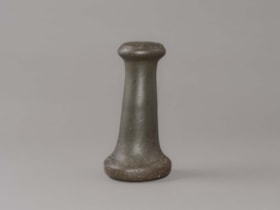
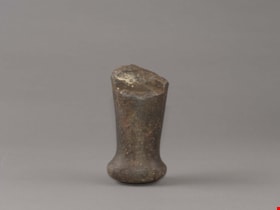
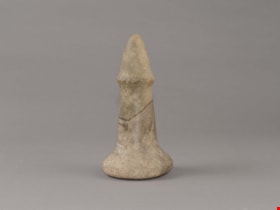
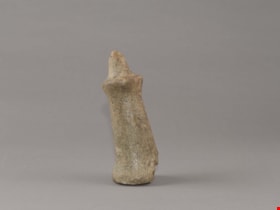
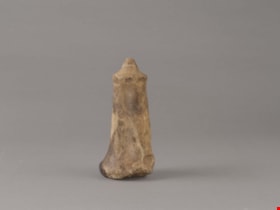
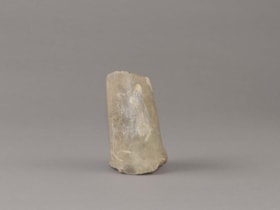
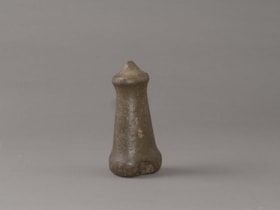
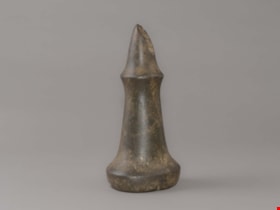
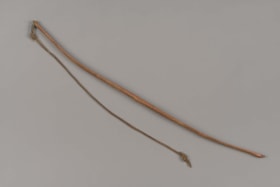
![Interview with Joanne Smith, [1986-2023] (interview content), interviewed 11 May 2023 thumbnail](/media/hpo/_Data/_BVM_Sound_Recordings/Oral_Histories/2023_0016_0005_001.jpg?width=280)
![Interview with Lama Tenzin Sherpa and Lama Sue Salter, [1977-2023] (interview content), interviewed 31 Jul. 2023 thumbnail](/media/hpo/_Data/_BVM_Sound_Recordings/Oral_Histories/2023_0016_0015_003.jpeg?width=280)
![Interview with Shirley Cohn, [1926-2023] (interview content), interviewed 2023 thumbnail](/media/Hpo/_Data/_BVM_Sound_Recordings/Oral_Histories/2023_0016_0001_001.JPG?width=280)
